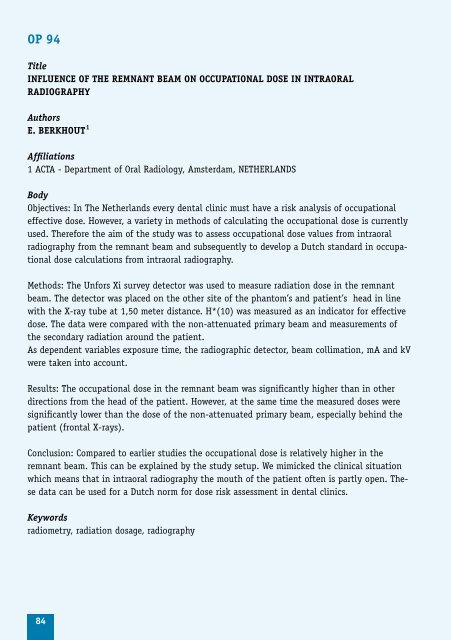Program including abstracts as pdf available here
Program including abstracts as pdf available here
Program including abstracts as pdf available here
You also want an ePaper? Increase the reach of your titles
YUMPU automatically turns print PDFs into web optimized ePapers that Google loves.
OP 94<br />
Title<br />
INFLuENCE OF THE REMNANT bEAM ON OCCuPATIONAL DOSE IN INTRAORAL<br />
RADIOGRAPHy<br />
Authors<br />
E. bERKHOuT 1<br />
Affiliations<br />
1 ACTA - Department of Oral Radiology, Amsterdam, NETHERLANDS<br />
Body<br />
Objectives: In The Netherlands every dental clinic must have a risk analysis of occupational<br />
effective dose. However, a variety in methods of calculating the occupational dose is currently<br />
used. T<strong>here</strong>fore the aim of the study w<strong>as</strong> to <strong>as</strong>sess occupational dose values from intraoral<br />
radiography from the remnant beam and subsequently to develop a Dutch standard in occupational<br />
dose calculations from intraoral radiography.<br />
Methods: The Unfors Xi survey detector w<strong>as</strong> used to me<strong>as</strong>ure radiation dose in the remnant<br />
beam. The detector w<strong>as</strong> placed on the other site of the phantom’s and patient’s head in line<br />
with the X-ray tube at 1,50 meter distance. H*(10) w<strong>as</strong> me<strong>as</strong>ured <strong>as</strong> an indicator for effective<br />
dose. The data were compared with the non-attenuated primary beam and me<strong>as</strong>urements of<br />
the secondary radiation around the patient.<br />
As dependent variables exposure time, the radiographic detector, beam collimation, mA and kV<br />
were taken into account.<br />
Results: The occupational dose in the remnant beam w<strong>as</strong> significantly higher than in other<br />
directions from the head of the patient. However, at the same time the me<strong>as</strong>ured doses were<br />
significantly lower than the dose of the non-attenuated primary beam, especially behind the<br />
patient (frontal X-rays).<br />
Conclusion: Compared to earlier studies the occupational dose is relatively higher in the<br />
remnant beam. This can be explained by the study setup. We mimicked the clinical situation<br />
which means that in intraoral radiography the mouth of the patient often is partly open. These<br />
data can be used for a Dutch norm for dose risk <strong>as</strong>sessment in dental clinics.<br />
Keywords<br />
radiometry, radiation dosage, radiography<br />
84


